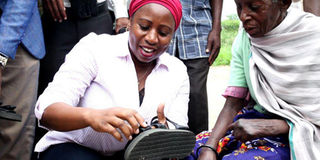Final push to eliminate leprosy in Tanzania needs impetus

Minister of Health, Community Development, Gender, Elderly and Children Ummy Mwalimu in a Samaritan village where people living with leprosy live in Hombolo, Dodoma region.
What you need to know:
The Leprosy and Tuberculosis care and Prevention Coordinator Dr Deusdedit Kamara from the National TB and Leprosy Programme (NTLP) highlighted the development as he was commenting on an international study that he co-authored, whose findings have raised hopes of eliminating leprosy in Tanzania and across the world.
Dar es Salaam. Tanzania has recorded a significant decline in cases of leprosy in recent years, however, the country’s final push for elimination of leprosy requires innovation, community involvement and key collaborators in legal and social sectors, said an expert coordinating national efforts to eliminate the bacterial disease.
The Leprosy and Tuberculosis care and Prevention Coordinator Dr Deusdedit Kamara from the National TB and Leprosy Programme (NTLP) highlighted the development as he was commenting on an international study that he co-authored, whose findings have raised hopes of eliminating leprosy in Tanzania and across the world.
Results , which were published on October 29(2020) in the Lancet Global Health, have shown that the screening and administering of preventive treatment to individuals who have been in contact with patients newly diagnosed with leprosy can help cut down the transmission of the bacterial infection.
The study, initiated by Novartis Foundation, involved 170,000 people in Tanzania, Brazil, India, Indonesia, Myanmar, Nepal and Sri Lanka. As the only African country that participated in the study, Tanzania needs to be innovative enough to deal with the disease and participating in such as study is one way, said Dr Kamara.
“We were the only African country that participated in the study because we were readily available to try new innovation,’’ he said, albeit adding that stigma still holds back the elimination efforts: “Much has been done but we are still a bit far to stop it completely.” Tanzania has been a key stakeholder in the final push strategy to eliminate leprosy as a public health problem for years.
“This [stigma] and all sort of discriminations are really multisectoral matter and national TB and leprosy prorgamme remains only a catalyst. Full involvement of people affected by leprosy and key collaborators and of course social and legal sectors would move the agenda strongly,’’ he told The Citizen.
The new study, which reveals an innovative approach that could help eliminate leprosy, comes at a time when sectors need to team up and eliminate the disease that sees over 200,000 newly diagnosed cases globally every year.
The Head of the Novartis Foundation Dr Ann Aerts said in a press statement released by Novartis that the results of the study mean we can finally imagine a world without leprosy.
“We would like to thank the governments, NGOs and investigators who worked with us to make this landmark initiative a reality, enabling postexposure prophylaxis to be translated into global health policy,” said Dr Aerts.
The research project, known as the Leprosy Post-Exposure Prophylaxis (LPEP) program traced 170,000 people who had been in contact with individuals newly diagnosed with leprosy, and treated 150,000 of them with a single dose of rifampicin to prevent disease.
“With this new approach, there is a much lower chance people with leprosy can pass on disease to neighbors and friends, preventing avoidable disability and stigma, in turn helping us to progress towards zero leprosy,’’ said Jan van Berkel, President of the International Federation of Anti-Leprosy Associations (ILEP) in a statement.
The approach, according to researchers, is feasible and efficient and acceptable among healthcare workers and the patients. If left untreated, leprosy can cause progressive and permanent damage to the skin, nerves, limbs, and eyes, leading to stigma and further spread of the disease
Findings have raised optimism that the approach, if scaled up globally, means that near-elimination of leprosy could become a reality in a single generation.
The lead author of the paper Professor Jan Hendrik Richardus from Erasmus MC, University Medical Center Rotterdam said, “The next step is to ensure that prophylactic treatment is rolled out in all settings where contact tracing and screening have been established.”
The prevalence rates of leprosy in Africa have generally dropped from 57, 516 cases in 2000 to 33 690 in 2010 according to data from World Health Organization (WHO).
In Tanzania, the only African country that participated in the study, the number of registered leprosy cases on multidrug therapy has gradually declined from nearly 3,500 cases in 2006 to 1,535 in 2018, as per data from the National TB and Leprosy Programme (NTLP).
Over two years ago, the World Health Organization (WHO) recommended the intervention in their 2018 Guidelines for the Diagnosis, Treatment and Prevention of Leprosy after it was found out it could reduce the risk of leprosy in contacts of leprosy patients by nearly 60%.




